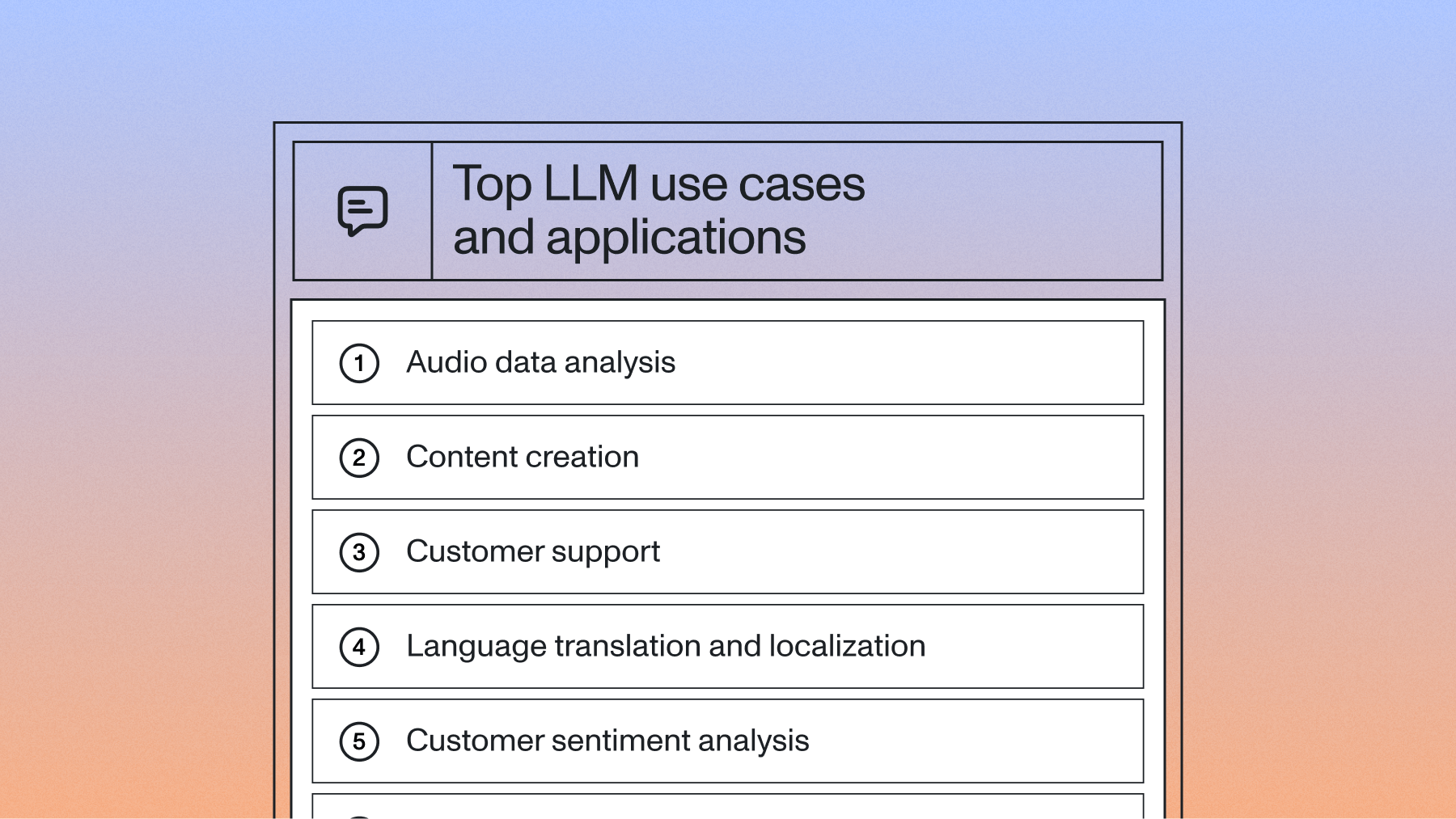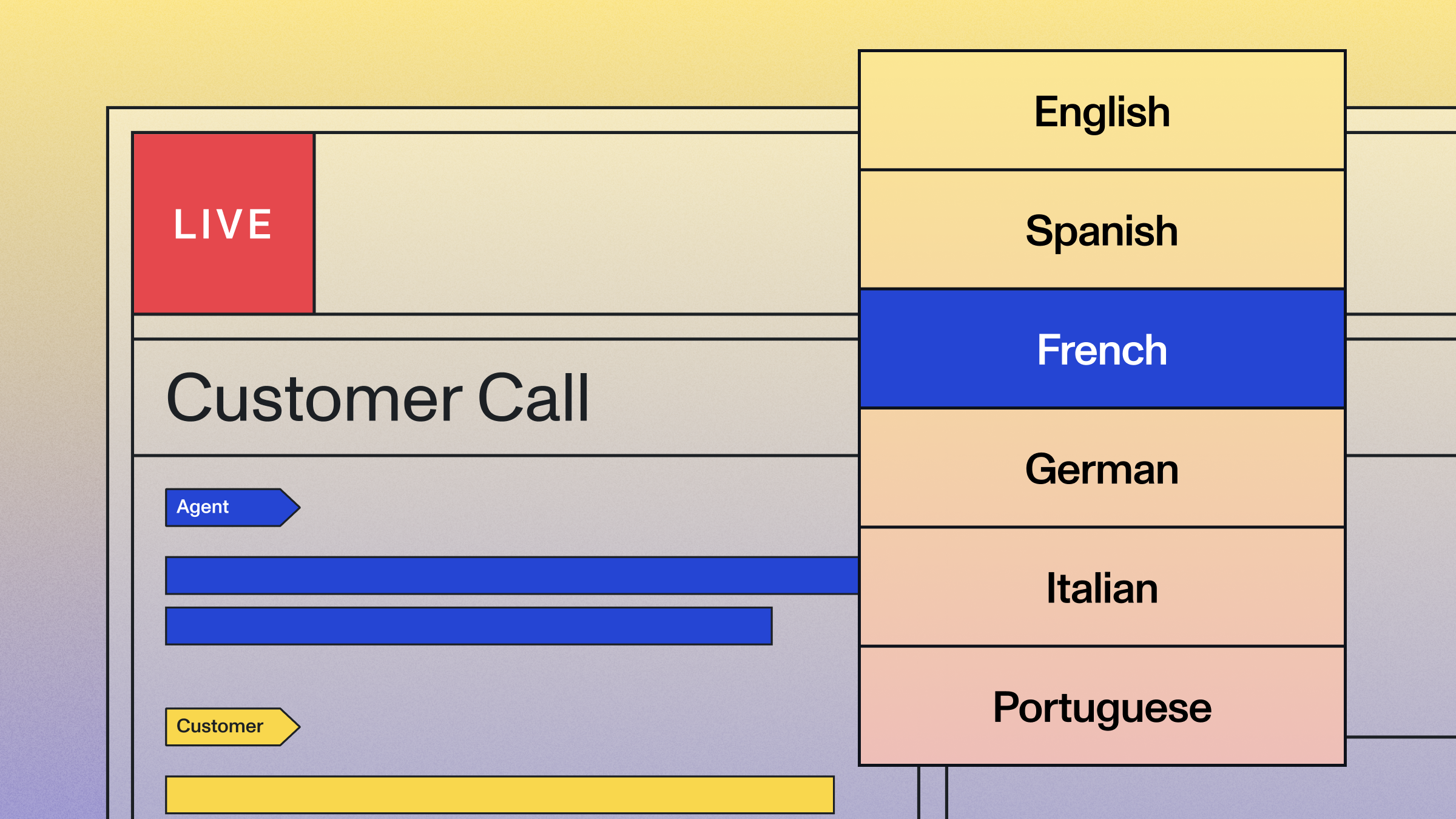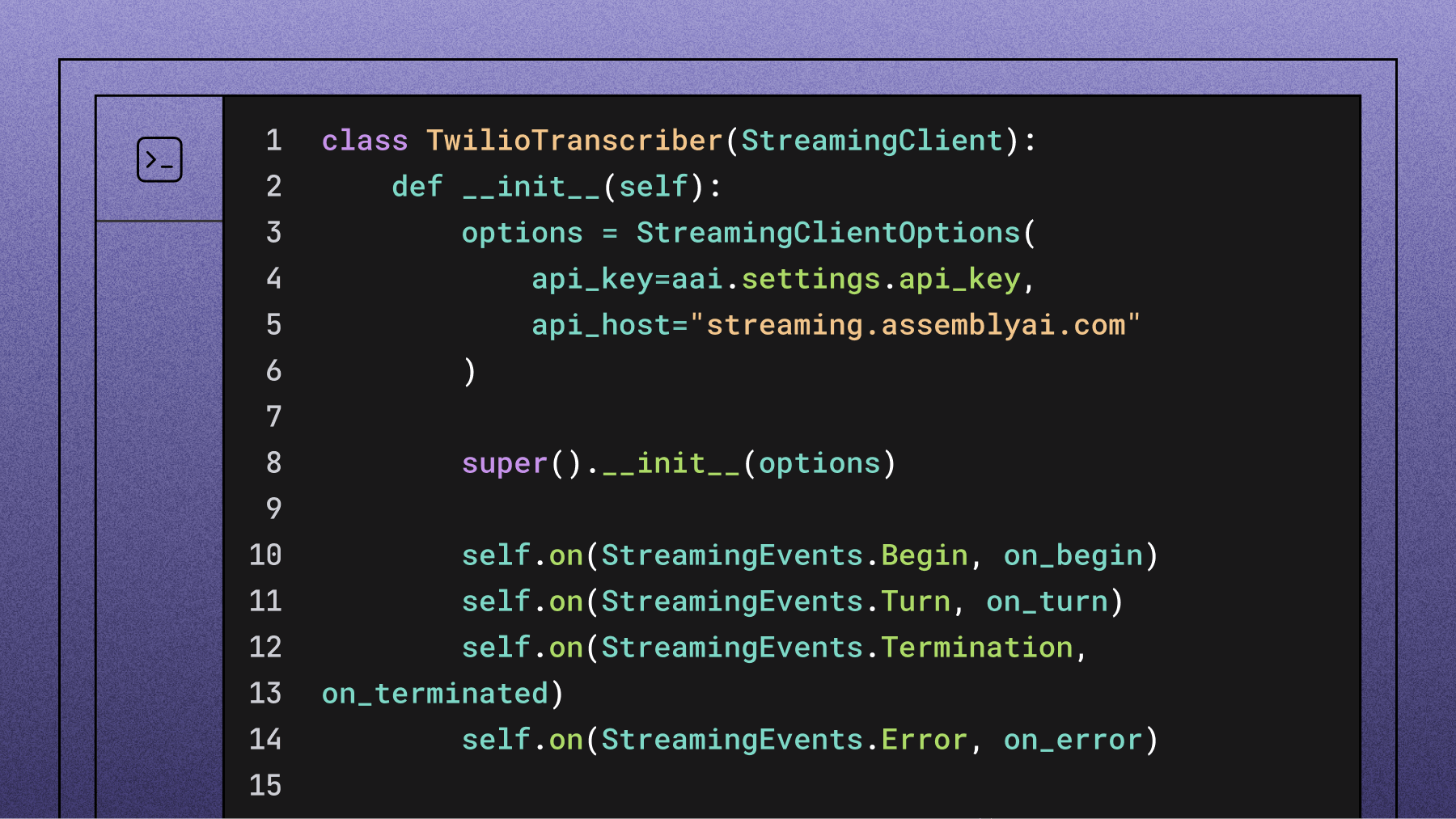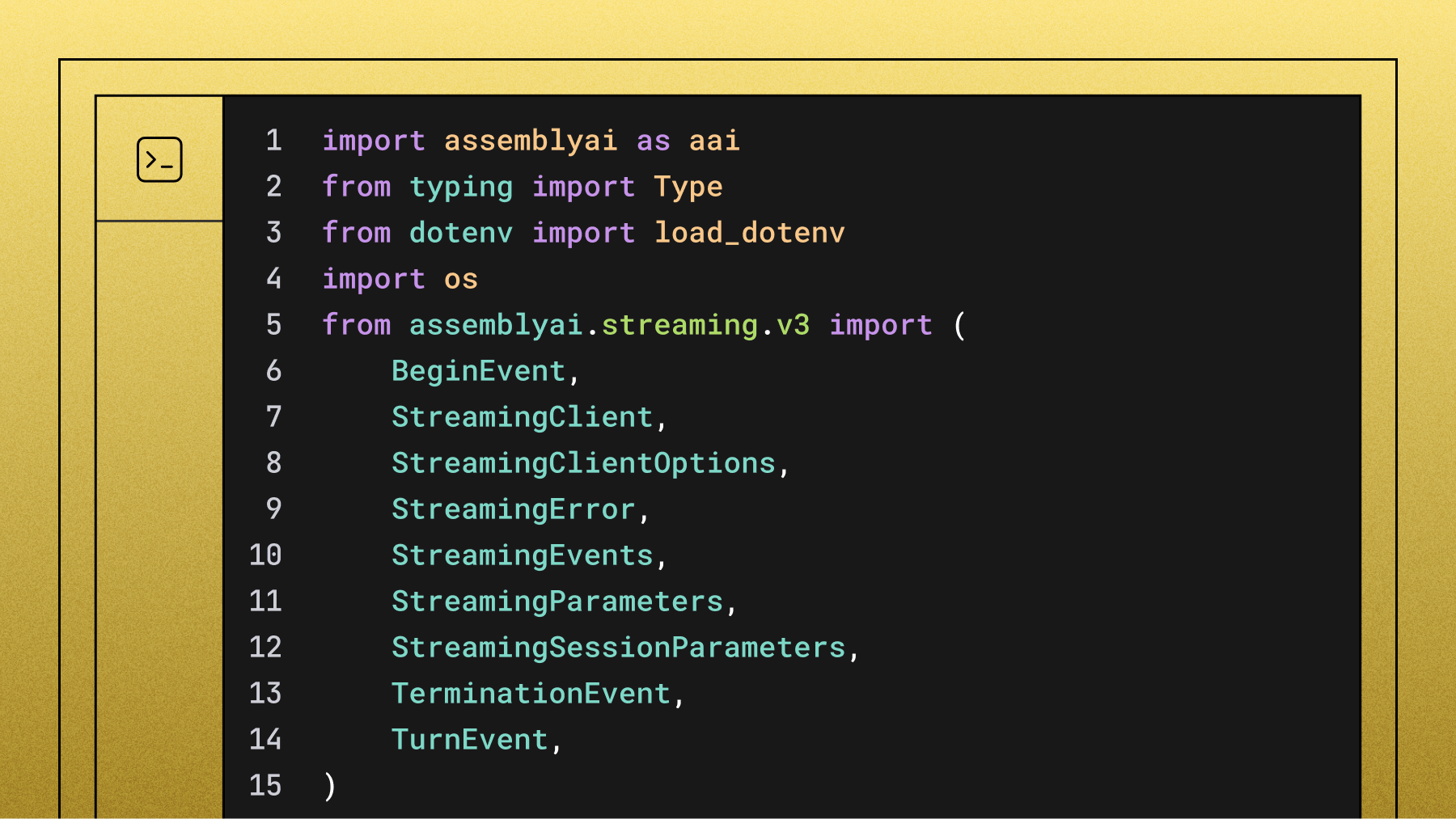10 ways streaming speech-to-text (live transcription) is being used today
Learn 10 ways streaming speech-to-text (live transcription) is being used today across industries.

%20is%20Being%20Used%20Today.png)

Streaming Speech-to-Text technology (also known as live transcription) converts real-time audio streams into accurate text. From live sporting events to conference calls, live transcription makes interactions more engaging and accessible for everyone, and, according to a recent industry report, over 80% of respondents predict that real-time conversation intelligence will be the most transformative capability in 2025.
A 2025 survey found that 76% of respondents already have conversation intelligence embedded in more than half of their customer interactions, with industries like financial services, health care, and customer support using the technology to drive engagement, improve accessibility, and generate immediate insights.
Below, we'll walk you through a handful of live transcription use cases we're seeing across industries. But first, let's quickly recap live transcription and why it matters.
What is live transcription?
Live transcription converts spoken language into written text in real-time using AI-powered speech recognition technology. Modern systems automatically transcribe conversations, meetings, and events with minimal human intervention, replacing traditional manual note-taking processes.
Live transcription relies on a combination of advanced speech recognition and natural language processing. Here's a high-level overview of the process:
- Audio Capture: The audio input is captured through microphones or other recording devices.
- Speech Recognition: The audio is processed by a speech recognition solution that converts the spoken words into text.
- Real-Time Display: The transcribed text is displayed in real-time, with minimal latency, to let viewers follow along as the speech happens.
Live Transcription vs. Post-Event Transcription
While live and post-event transcription serve the same purposes, they do it in different ways:
- Timing: Live transcription happens in real-time during the event, while post-event transcription is done after the event has concluded.
- Accuracy: Post-event transcription can be more accurate since it allows for editing and correction, whereas live transcription prioritizes speed and may include minor errors.
- Usage: Live transcription is ideal for accessibility during live events, webinars, and meetings, providing immediate text for participants. Post-event transcription is used to create detailed, polished records for future reference, sharing, analytics, and archiving.
What are the benefits of live transcription?
While the end result of live transcription is simply written text, there's a lot you can do with a transcription versus only the audio recording. From improved accessibility to searchability and analytics, Streaming Speech-to-Text can help in several ways:
- Improved Accessibility: Makes spoken content accessible to individuals who are deaf or hard of hearing.
- Higher Engagement: Helps participants follow along (especially in noisy environments or speakers with strong accents).
- Better Record-Keeping: Offers an immediate and accurate record of spoken content—essential for meeting minutes, legal records, or educational notes.
- Greater Searchability: Lets users find specific information or topics for reviewing content, preparing summaries, and extracting key points
- Language Translation: Can be paired with translation services to provide real-time subtitles in different languages.
- Regulatory Compliance: Provides a verifiable record of interactions for accurate documentation.
- Analytics: Empowers advanced analytics by providing structured data, ready to be analyzed to extract insights, identify trends, and measure performance.
ROI and cost savings from live transcription
Live transcription delivers measurable business value through three key areas: efficiency gains, accessibility compliance, and competitive opportunities.
Cost reduction: Automating documentation reduces manual transcription costs by 60-80% while freeing teams for strategic work.
Revenue opportunities: Real-time conversation analysis enables immediate response to sales signals and customer issues. In fact, research shows that teams see boosted sales outcomes and even topline revenue growth by using live insights for coaching and opportunity identification.
Market expansion: Accessibility compliance opens new customer segments and reduces legal risk.
Implementation considerations for enterprise deployment
Integrating live transcription into your product or workflow requires a strategic approach. It's more than just finding an API; it's about choosing a partner that can scale with your vision.
Building world-class Voice AI in-house requires massive investment in specialized talent and infrastructure. Partnering with proven providers lets you focus on core product differentiation, and as one industry leader advises, "The technology is evolving quickly—you won't be able to keep pace with your own tech."
10 real-world live transcription use cases
Live transcription accuracy now exceeds 95% in real-world conditions, with response times under 300ms enabling natural conversation flow; in fact, industry analysis confirms that this speed is critical for maintaining high accuracy across diverse acoustic conditions. Here's how organizations across industries are implementing this technology for measurable business results.
1. Live Broadcasts
Live transcription in broadcasts creates on-screen subtitles or captions for viewers to follow. You'll see this for everything from live sporting events and concerts to social media live streams and even gaming streams.
During the event, these live transcriptions make the content more accessible and easy to follow (especially for those who prefer to read content). Following the live event, the transcribed content helps create searchable archives.
Business impact: Organizations report 40-60% reduction in documentation overhead and 95%+ participant satisfaction with accessibility features.
2. Virtual Meetings and Conferences
Everything from team meetings and company all-hands to virtual conferences or hybrid events can benefit from live transcription. This could be creating real-time captions to follow along with or even on-display transcriptions on a digital screen during an in-person event.
You can even feed the live transcript into third-party translation services to provide real-time subtitles in multiple languages. Participants can focus more on the discussion rather than taking notes—because the platform can process the live transcript to distinguish between speakers (when using multichannel audio), summarize meetings, and even highlight takeaways and action items.
Business impact: Companies see 70% reduction in post-meeting documentation time and 30% improvement in meeting productivity.
3. Customer Service and Support
Live transcription supports customer service agents and callers by providing real-time text of customer interactions. This allows for immediate analysis, documentation, and follow-up—it can even alert managers and higher-ups if they might need to hop on a call to help or intervene.
The live transcriptions can be stored for documentation, reference, or analysis following the interactions. You can use these learnings to power agent training and learn which strategies work (or don't), and recent survey data shows that 69% of companies report improved customer service after implementing features like post-call reviews and scorecards.
Business impact: Contact centers report 25% improvement in first-call resolution rates and 35% reduction in quality assurance costs.
4. Education and Online Learning
Schools, colleges, and online learning programs can use live transcription services to provide accurate and timely notes. It can help with lectures, seminars, interactive sessions, and workshops.
Students can focus on understanding and participating in the lesson rather than frantically taking notes. Transcripts can be reviewed later for better retention. Transcription can also be integrated with more interactive tools to let students highlight, comment, and discuss specific parts of a lesson.
Business impact: Educational institutions see 40% improvement in student comprehension scores and 85% increase in content accessibility compliance.
5. Legal Proceedings
Live transcription in legal proceedings provides real-time text conversion of courtroom discussions, depositions, and other legal activities. This provides accurate and immediate records of documentation, legal accuracy, and accountability.
Layers, judges, and jurors can use live transcription services to better follow conversations in real time. Some attorneys can speak quickly—having a transcription helps everyone stay on the same page. Journalists can also use live transcriptions to get instant access to accurate quotes and proceedings to use in timely articles without waiting for official post-event documentation.
Business impact: Legal teams reduce documentation costs by 50% and improve case preparation efficiency by 60%.
6. Health care and Telemedicine
Healthcare organizations and telemedicine can use live transcription to convert spoken medical consultations, patient interactions, and clinical discussions into real-time text. This is especially important for increasingly prevalent virtual care when sound quality and accents could lead to misunderstandings or miscommunication.
Creating accurate, real-time documentation of medical consultations reduces the risk of errors in patient records. It also gives all patients instant access to important medical information.
Administrative roles can also use live transcription to streamline transcribing medical conversations, allowing them to focus more on patient care and less on scribbling notes.
Business impact: Healthcare providers report 60% reduction in documentation time and 90% improvement in medical record accuracy.
7. Financial Services
The financial services industry can use live transcription for client meetings, investment briefings, and earnings calls. This improves transparency, compliance, and accessibility.
These live transcriptions provide accurate records for immediate review and analysis. It keeps all interactions documented accurately for searchable records and potential auditing.
Business impact: Financial institutions achieve 100% compliance documentation and 45% reduction in meeting follow-up time.
8. Government and Public Sector
Government organizations can use live transcription for in-person meetings, public hearings, press conferences, town halls, and other official events. This makes all the proceedings more accessible to your community and creates accurate, searchable records for documentation and historical archiving.
Business impact: Government agencies report 80% improvement in public information accessibility and 50% reduction in FOIA request processing time.
9. Market Research and Focus Groups
Market research organizations use live transcription for real-time discussions, interviews, and focus groups. Having instant access to these transcriptions allows for immediate consumer insights, trends, and preferences analysis. It also lets you ask more relevant follow-up questions rather than collecting and gleaning all the insights post-discussion when your group is no longer accessible.
Automated transcription reduces human error and also lets your team stay engaged in the conversation rather than note-taking, which research highlights as key for generating insights for product development and strategic planning. Following the interviews, researchers can quickly compile large volumes of data from multiple focus groups for more extensive analysis.
Business impact: Research teams see 70% faster insight generation and 40% more actionable data from sessions.
10. AI-Powered Live Assistants
AI-powered live assistants change how we interact with technology and access information in real-time. They combine live transcription and natural language processing with text-to-speech systems to provide immediate, accurate responses to user inputs and questions.
For example, during live events or meetings, AI-powered live assistants can transcribe spoken words into text and then process that text to generate relevant answers, summaries, or follow-up questions.
In customer service, AI-powered live assistants can handle multiple queries simultaneously to provide real-time support and free up human agents for more complex tasks. The integration of live transcription with AI allows these assistants to understand context, detect sentiment, and offer personalized interactions.
Business impact: Organizations deploying AI assistants see 50% reduction in support costs and 3x improvement in response times.
Industry applications and business outcomes
Live transcription transforms specific industries through measurable business outcomes and proven implementations.
- Legal tech: JusticeText reduces evidence processing time by 70% for public defenders, improving case preparation efficiency
- Media & broadcasting: Companies like Veed and Podchaser achieve 99%+ content searchability with automated transcription
- Customer support: CallSource and Ringostat see 25% improvement in agent performance through real-time conversation analysis
- Healthcare: T-Pro and Call 4 Health reduce clinical documentation time by 60%, allowing more patient focus
These examples show that the most successful implementations go beyond simple transcription. They integrate Voice AI deeply into their core workflows to solve specific industry problems and deliver measurable business outcomes.
Build live transcription solutions with an AI partner
Integrating live transcription into your products, services, events, and experiences doesn't need to require heavy upfront investments or vast technical resources—you just need the right partner.
Look for advanced speech-to-text solutions that provide unmatched accuracy, scalability, and reliability:
- High Accuracy: Achieve near-human level transcription accuracy with state-of-the-art models (even with poor audio conditions like noisy backgrounds).
- Scalability: Handle large volumes of audio and video data seamlessly, whether it's for small teams or large enterprises.
- User-Friendly API: An API that is simple to integrate, letting you quickly start transcribing and analyzing audio data.
Test our API in minutes in our Playground and see how easy it is to transcribe and analyze audio in real time. Ready to start building? Sign up for a free account and receive credits to start transcribing and exploring our Speech Understanding models.
Frequently asked questions about live transcription
What ROI can we expect from live transcription implementation?
Organizations typically see 60-80% reduction in manual documentation costs and 25% improvement in operational efficiency. ROI varies by use case, but most implementations achieve positive returns within 3-6 months.
How long does enterprise deployment typically take?
Basic integrations typically take 1-2 weeks, while full enterprise deployments range from 4-12 weeks depending on system complexity.
How does live transcription integrate with existing business systems?
Live transcription integrates via an API, which allows it to connect with virtually any software, from CRM and communication platforms to custom-built applications. This flexibility enables you to embed real-time transcription directly into your existing workflows without needing to replace your current tools.
Which industries see the highest adoption rates for live transcription?
We see high adoption in customer service, media and entertainment, healthcare, financial services, and legal tech. These industries have a clear and immediate need for accurate, real-time documentation, accessibility, and data analysis from spoken conversations.
What are the key differences between live and post-event transcription for business applications?
The main difference is timing and purpose. Live transcription is for in-the-moment applications like real-time captioning, agent assist, or immediate data analysis. Post-event transcription is used when a polished, editable record is needed after an event for archival, content creation, or detailed analysis.
Lorem ipsum dolor sit amet, consectetur adipiscing elit, sed do eiusmod tempor incididunt ut labore et dolore magna aliqua. Ut enim ad minim veniam, quis nostrud exercitation ullamco laboris nisi ut aliquip ex ea commodo consequat. Duis aute irure dolor in reprehenderit in voluptate velit esse cillum dolore eu fugiat nulla pariatur.







